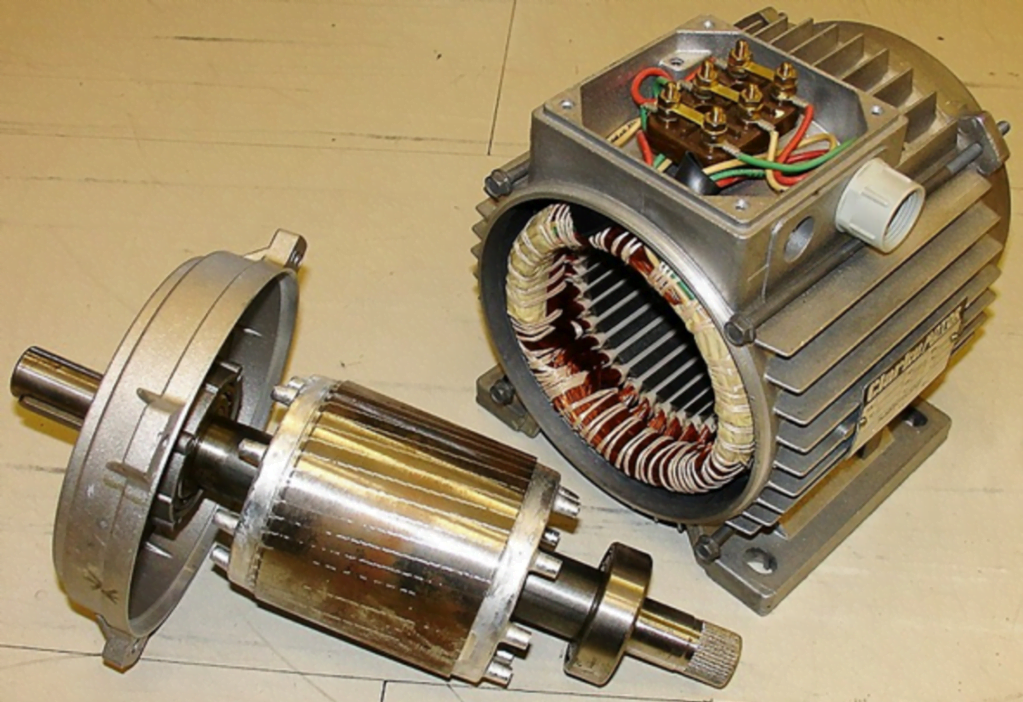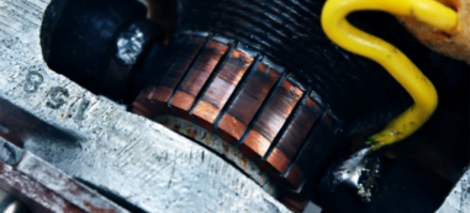Electric vehicle motors
AC/DC
Electric vehicle motors use one or other of the two main kinds of electricity: alternating current and direct current. Both are effective as electric vehicle motors.
Alternating Current (AC) is where electric current constantly reverses its direction. It is that used in grid power supplies. In Australia and many other countries it cycles at 50 times a second. In America it cycles at 60 times a second.

Tesla Roadster AC motor. Pic: Tesla.
The AC induction motors used in a few electric vehicles have a stator (stationary coils of wire). When AC current flows through it, the stator generates a rotating magnetic field. That in turn causes a rotatable armature to revolve. It rotates at the rate of the AC current: i.e. at 50 or 60 times a second.
The relationship between AC voltage and its frequency enables changes in vehicle speed. The batteries’ DC output is converted to AC by an ‘inverter’. All that required is an inverter that has variable frequency. This is effective, but not that efficient.
AC induction motors are often used in hybrid vehicles. These use electric drive for limited commuting. Efficiency and range are not seen as major factors. There is however an increasing trend to direct current (DC) motors for electric vehicles.
Electric Vehicle Motors – Direct Current (DC)
Direct current (DC) is a flow of electrons in one direction. Edison is often credited as conceiving it. It was, however, initially conceived (in 1800) by Alessandro Volta. The term ‘Volt’ commorates his name.
A basic DC motor has fixed external magnets. These surround a revolving armature that is an electromagnet. It also doubles as the drive shaft. Direct current is fed to this electromagnet via a commutator.
Electric Vehicle Motors – commutators & brushes
The commutator is a basic DC motor’s weak point. It is a small ‘drum’ made of an electrically-insulating material. This drum has a number of copper segments. Carbon brushes, that conduct the DC current, are sprung against these segments.
The direct current is fed to the revolving armature via those brushes. This creates a magnetic field in the armature. The magnetic field causes the armature to spin through 180 degrees. A further mechanism causes the current fed to the brushes to reverse the DC’s polarity for the second 180 degrees. And so on.
While these motors work well, the carbon brushes sprung against rotating segments, wear out. They also constantly spark. This is a potential fire hazard. Moreover, it causes electrical ‘noise’ that must be suppressed.
A few electric vehicles use basic DC motors originally designed for other purposes. There are, however, many variants that combine the benefits of both AC and DC.

A DC electric motor’s commutator. One carbon brush is attached to the yellow lead. A second (out of sight) is on the left.
Brushless DC motors
A Brushless DC motor (BLDC), is in effect a DC motor turned inside out. It has permanent magnets on the rotor that generate a rotatable magnetic field on its outside. An electronic sensor monitors the angle of the rotor. Then, via high power transistors, it applies current to generate an external electromagnetic field. That field creates a turning force.

Brushless DC motor – Pic: original source unknown
Maximum torque at zero speed
Brushless DC motors develop maximum torque at zero speed. They are efficient electrically. Moreover, they have no brushes that wear out, and no need for internal cooling. Furthermore, this enables its internal bits and pieces to be free of contamination.
These motors produce far more torque than fossil-fuelled motors of comparable size and/or weight. They can rotate at far greater speed. They are relatively light and compact. Their available power is primarily limited by heat.
BLDC motors have minor downsides. They cost more to make than their brushed counterparts. Furthermore, d at present, the permanent magnets field strength is not adjustable. Work is in progress to make it so. Once achieved that will enable increasing maximum torque at low speeds when required. This is likely to be done by using neodymium (NdFeB) magnets.
Brushless DC motors cost more than most electric motors but are nevertheless proving commercially successful. They are used for Tesla’s Model 3. It seems likely they will dominate the market.
The Electric Vehicle Series
This is a part of a series of articles about the history and technology involved in electric vehicles.




